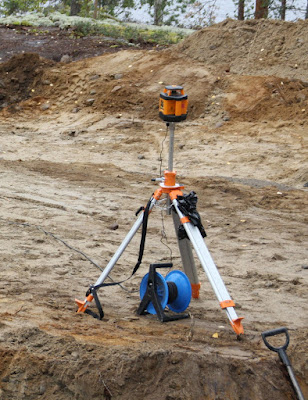Il y a trèèèès longtemps, j'avais commencé sur ce blog une série sur la construction d'un mökki (chalet en bois finlandais). Le mökki est maintenant bien avancé et il est temps que je rattrappe un peu mon retard sur ce plan ; il paraît que certains de mes lecteurs suivent cette petite aventure avec beaucoup d'attention !
A veeeeeery long time ago, I had started on this blog a serie of posts about the construction of a mökki (Finnish wooden summer house). I might as well continue with it, since the mökki building process is now almost completed and I have been told that some of my readers are interested in that little adventure !
Lors des précédents épisodes (épisode 1, épisode 2) je vous avais parlé des deux premières étapes : le déblayage (le terrain étant recouvert d'arbres) et le creusement du trou pour les fondations. Avec la troisième étape, nous entamons la construction véritable, en commençant par la partie sous-terraine.
Les fondations sont composées de blocs de béton qui reposent sur une petite épaisseur de sable bien tassé, mais ce n'est pas aussi simple que ça. Car ça paraît assez évident, mais une maison a plutôt intérêt à être parfaitement horizontale. Pour ça, l'arme suprême, c'est cet étrange outil sur un trépied qu'on appelle un laser.
During the previous episodes (episode 1, episode 2), I showed you the two first steps : cleaning the field from its trees and digging the hole where the house will stand. This third step takes us to the actual buidling : the foundations.
This mökki's foundations are made of concrete blocks lying on a small layer of pressed sand, but it's not that simple. It seems quite obvious, but a house should be perfectly horizontal. For this purpose, the supreme weapon is this strange tool on a tripod called a laser.
This mökki's foundations are made of concrete blocks lying on a small layer of pressed sand, but it's not that simple. It seems quite obvious, but a house should be perfectly horizontal. For this purpose, the supreme weapon is this strange tool on a tripod called a laser.
Son fonctionnement est assez simple : le trépied, une fois réglé, envoie un signal (la lumière rouge) à un "bâton". Le trépied émet un signal sonore. Quand le bâton se trouve exactement à la hauteur fixée, le signal est continu ; quand il est trop haut ou trop bas, c'est un signal interrompu, à une fréquence différente pour le trop haut et pour le trop bas. Celui qui manie le bâton sait donc quand il faut le remonter ou le redescendre, et en fonction, on ajoute ou retire du sable. Répétez l'opération sur toute la longueur des fondations, et vous aurez une maison horizontale.
Its functioning is rather simple: one set up, the tripod sends a signal (a red light) to a "stick". The tripod also beeps: when the stick is at the set up height, the beep is continuous; when it's too high or too low, it beeps in a different way, so that the one who manipulates the stick knows when to rise or lower it. According to this indication, the level of sand is adjusted. The same operation is repeated all over the foundations, and there comes a horizontal house.
Là-dessus, ajoutez les blocs de béton appropriés. Ne pas oublier de laisser passer les tubes électriques et les canalisation qui fourniront la maison en eau et en électricité ; ils seront incrustrés directement dans les fondations et enterrés. Pour que les blocs tiennent, on remplit le reste du trou avec de gros graviers. Par rapport au sable, le gravier a l'avantage d'être moins cher et plus stable ; le sable risque de se tasser, le gravier pas.
On top of the sand come the appropriate concrete blocks. Electric tubes and water pipes that will provide the house with electricity and water from outside come under the blocks and will be embedded directly in the foundations. For the blocks to held, the rest of the hole is filled with gravel. Gravel is cheaper and more stable than sand: sand might collapse, gravel won't.
Et voilà le travail : c'est sur ces fondations que la maison se dressera. Il y a de tels blocs en-dessous de tout ce qui soutient la maison : les murs extérieurs et les piliers sous l'auvent. Et bien évidemment c'est le même principe pour le garage. Par contre déplacer tout ce sable et ces graviers c'est un travail éreintant et relativement lent ; entre le début et la fin, il y a eu plus d'un mois (en ne travaillant que le week-end), et fin octobre le temps s'était déjà bien rafraîchi... Mais les fondations ne sont pas finies pour autant !
Here we are: these foundations will stand the house. Such blocks are to be found under every pice of construction holding the house: outside walls and pillars. And of course the same is true for the garage. Moving all this sand and gravel is a slow and painful work; between its beginning and its end, more than a month had passed (working only during the week-ends) and the weather was much cooler at the end of october... But these foundations are not ready yet!











Ha oui! ,quelle bonne idée de nous faire vivre la construction d'un (ou d'une ?) Mökki !
ReplyDeleteMerci pour celà aussi !